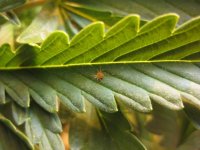mostnonymouse
Member
Forgive my ignorance, but I've been fortunate enough to have never dealt with spider mites before. While these look to me like red baby spiders, I'd like a second look for some peace of mind. They are fast as fuck and look (to my untrained eye) to be far too large to be spider mites... They've just been bolting up, down, and all around my leaves nonstop. For reference, that blade he's on is about the width of my fingernail.


 Thanks fellas.
Thanks fellas.


